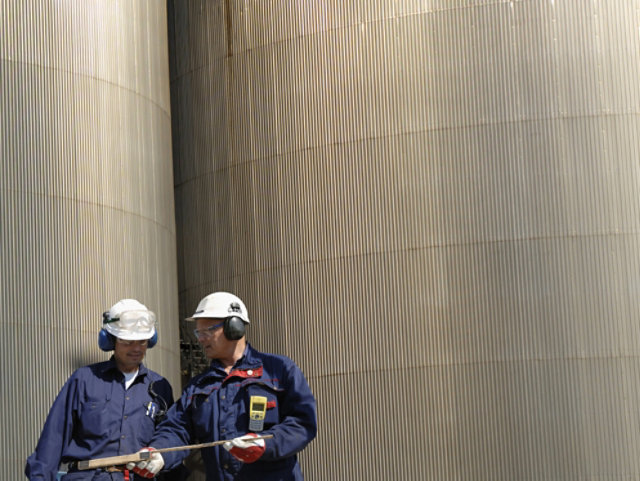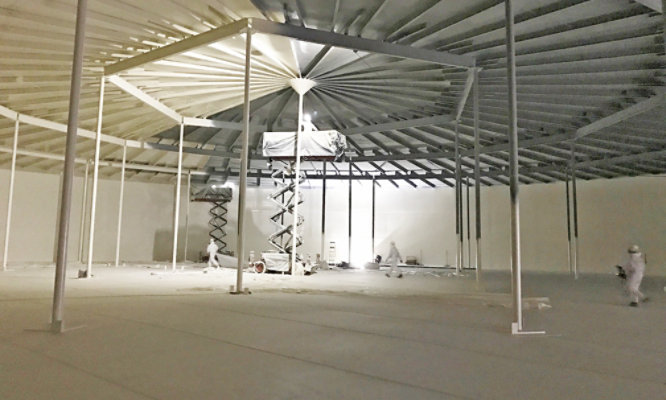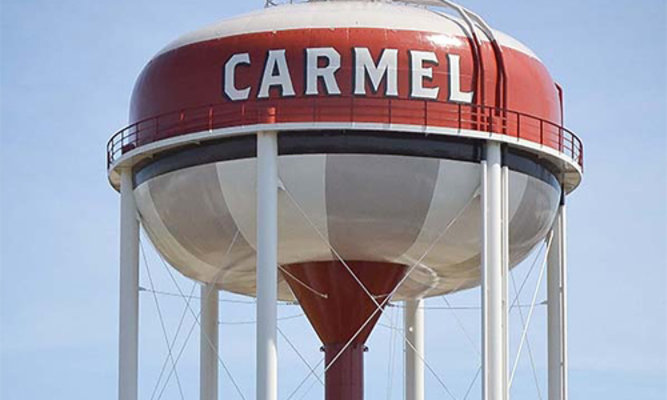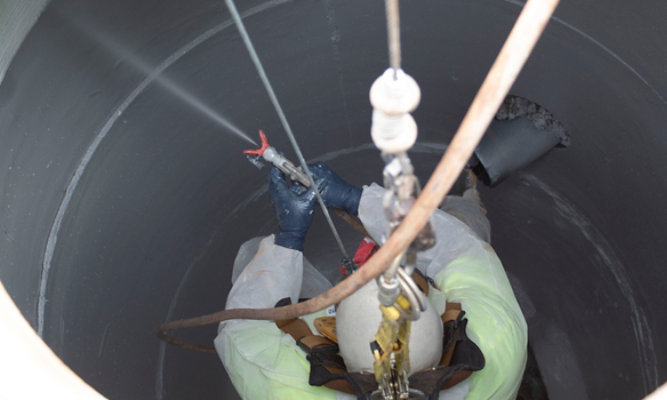
How to Choose between Flexible or Rigid
Learn how to choose between the two lining types for water and wastewater concrete tanks.
Find this article on page 9 of our new custom publication, Market Pulse - Advancements in Coatings Technology, featuring industry trends and thought leadership.
Specifying the optimal lining type for concrete water and wastewater treatment assets can help reduce the total cost of ownership for those assets. However, picking the right lining for the application can be tricky. The most tried-and-true types are either rigid epoxy liners or flexible elastomeric urethane liners. These two lining types greatly differ in their composition and performance, but are often misused or used interchangeably, against manufacturer guidelines.
The wrong choice can lead to failure, costly replacements, outages or overall system breakdowns. Conversely, the right choice will extend the interval between lining repairs or replacements and will increase the life of the asset itself.
Too often, municipalities make a choice between these two lining types for the wrong reasons – because they misunderstand the relative benefits of the linings; they had a previous experience – good or bad – with one of the lining types; or the applicators favor one over the other. No one lining type is better for all situations. The best choice depends on the particular application.
Let’s take a look at the basic reasons why you would choose one lining over the other. This brief discussion will inform and enable you to hold more productive conversations with engineering firms, contractors and coatings suppliers about which liners will benefit all the stakeholders involved.
Basic Advantages of Rigid and Elastomeric Liners
The basic advantages of rigid epoxy linings and flexible elastomeric urethane linings are easy to grasp. Epoxy linings are able to tolerate a moisture-rich environment or substrate, which is a valued quality because in existing concrete structures, moisture may be hard to avoid. Elastomeric linings cannot tolerate moisture.
On the other hand, elastomeric linings have elongation properties that enable them to withstand the effects of settling, loading, and expansion and contraction due to temperature. By contrast, rigid epoxy linings cannot handle movement in a concrete structure and will develop cracks under these stresses.
While these differences seem simple and clear, a final determination as to which lining type to apply to any given concrete asset can be quite complex and should be reached through consultation among the engineering consulting firm, the contractor, the supplier and the owner.
How Moisture Affects Lining Choice
Many water and wastewater structures were originally placed into service without linings. Moisture penetrates deep into the capillary pores of the concrete and remains there, even when the surface appears dry – a condition referred to as saturated surface dry (SSD). Elastomeric urethanes cannot be applied over an SSD substrate because the isocyanate component in the lining reacts with the water before it reacts with the polyol resin. The result is blistering. For pre-existing concrete structures in which moisture is still present in any form, rigid epoxy linings are the better choice.
There are some water and wastewater applications that cannot be taken offline fully. Water may be diverted or the level of water may be reduced, but it is still flowing and turbulent, creating a mist. Even in these conditions, an elastomeric urethane will be problematic because of the airborne moisture. An epoxy lining would be recommended instead.
How Movement Affects Lining Choice
The walls of many concrete structures move ever so slightly. They may shift in the earth, settle, or expand and contract due to changes in temperature. This movement is not visible to the naked eye, but it is enough to create hairline cracks in the structure. These cracks may be telegraphed through a rigid liner. With additional movement, the cracks may grow larger than a hairline. Rigid liners are not able to bridge these cracks and, therefore, are not recommended in such applications. Elastomeric urethanes, on the other hand, have elongation properties that enable them to bridge hairline cracks that may develop as the concrete substrate moves.
How does one know whether a concrete structure will move? The age of the structure is one indication. For example, a 40-year-old tank that has had time to settle in the ground – and has been loaded and unloaded many times – will be less prone to move further. On the other hand, a tank or basin that has never been loaded will be subject to significant movement as it takes on water for the first time.
Size and type of construction are other variables that determine whether a concrete structure will move. Small structures that are precast, cylindrical in shape and reinforced with small wire mesh are less prone to movement than larger structures that are poured in place and reinforced with rebar. In wastewater systems, for example, rigid epoxy liners are often applied with success to smaller structures like manholes, lift stations, wet wells and influent channels.
One category of rigid epoxy liners is referred to as “high-strength” or “semi-structural” because of its exceptional compressive, flexural and tensile strength. In addition to their other benefits, epoxies in this category may add to the physical characteristics of a concrete structure. This improvement is not drastic, but according to the research, there is a benefit in this area.
Depending on the size of the treatment facility, clarifiers, digesters and aeration basins may be candidates for epoxy linings or elastomeric linings. In addition, any structure that may be constructed with CMUs (concrete masonry units) would be subject to movement and therefore would require elastomeric linings.
In water treatment plants, as opposed to wastewater, many of the concrete structures would be considered large, e.g., 200 feet long by 100 feet wide and 40 feet deep. Structures of this size, including flocculation basins, sedimentation basins, filtration basins and ground water storage tanks, would be better served with elastomeric linings.
For heavily chlorinated water, epoxies may be preferred because they hold up better under exposure to this chemical. On the other hand, chlorine contact basins may contain baffle walls constructed of CMUs, which would argue for an elastomeric lining because the CMUs are subject to movement.
How Climate Affects Lining Choice
The geographic region, time of year and climate should all be considered when choosing a lining type. Urethanes cure better in colder temperatures than epoxies, but epoxies can handle airborne moisture and high relative humidity. If the project is taking place during winter in the midwestern U.S., an elastomeric urethane may be the better choice, but during the summer in the southeastern U.S., an epoxy lining may be a better choice.
How Equipment and Cost Concerns Affect Lining Choice
Elastomeric urethane linings are typically more complicated to apply than rigid epoxy linings. They also require plural-component application equipment that some applicators may not possess or have the means to purchase. In addition, among those applicators who have plural component equipment, some may lack the experience to anticipate or recognize complications underlying the application of elastomerics.
Some rigid epoxy lining formulations also require plural-component equipment, but there are technologies on the market now that allow for single-leg spraying of rigid epoxy liners, with results that are equal to plural-component spraying. There are still benefits to plural-component spraying, but these pertain more to the applicator, who will be able to reduce waste and the amount of solvent required for the application.
One benefit of single-leg spraying of epoxy linings is that more contractors can compete for an epoxy lining project, which may hold down costs for the owner.
Some Conclusions – Be Wary of Easy Answers
Armed with the knowledge in this overview, you should be able to enter into a constructive conversation with your engineering firm, applicator or coatings supplier about the merits of rigid versus flexible linings. These decisions are often complex – and usually involve many variables, not one. It’s appropriate to ask lots of questions before deciding on a lining type.
Unfortunately, there are many shortcuts to a simple answer. For example, some specifiers may cut and paste specifications from one project to another without adequate thought about how the applications differ. Similarly, contractors may only be comfortable applying one type of lining, or suppliers may have only one type of lining available.
These are situations that you can question, raising points that argue for one type of lining over another. The best scenario is always a constructive discussion that involves all parties focused on the unique characteristics of the individual application. If cost enters the picture, as it surely will, be sure to consider not only the initial cost of the lining, but also the life cycle of that lining (i.e., how soon you will need to repair or replace it). In general, life cycle questions will make the greatest impact on your bottom line over the long run.
Discover More
Industry Expertise and Innovation
See how we help customers find customized solutions for their project and application challenges.
Our Water & Wastewater Expertise
Explore our industry solutions and technology to help protect your assets.
LEARN MOREProduct Lookup
Find out more about our innovative coatings for a variety of industries.
FIND A PRODUCT


